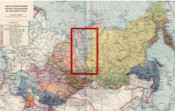
Embassy led by prince Toyan came to Moscow to Boris Godunov
As the Russian centralized state was taking shape and strengthening, territory was expanding too, mainly due to the development of new marginal lands. In the 16th century began the development of Siberia. Already in the 1580-1590s were created the first cities, such as Tyumen (1586), Tobolsk (1587), Tara (1594), Surgut (1594), Narym (1596), Verkhotursk (1598), etc. As a result, by the early 17th century much of western Siberia was opened up. At the beginning of the 17th century began the development of the eastern Siberia, and later of the Amur region. Siberia attracted developers, above all, by its innumerable fur wealth, which interested both "merchants" and the growing state. In Moscow, the development of Siberian land was regarded as a task of paramount importance to the state.
In the summer of 1603, an embassy of a Tatar prince eushta Toyan set out for Moscow to see Tsar Boris Godunov. 20 (30) January, 1604 he arrived to the capital and submitted a petition to the tsar, asking to make his tribe a subject of the Muscovite state and to construct a Russian city in his land. Boris Godunov took Toyan’s tribe under the patronage of Moscow, his subjects were exempt from tribute, in contrast to neighboring peoples.
March 25 (April 6), 1604 Boris Godunov sent a Cossack's head Gavrila Pisemskiy of Surgut and a Strelets head Vasiliy Tyrkov of Tobolsk on a mission to found a fortress on the banks of the river Tom’, in the Tatar land, to organize around it the monarch’s arable land and make surrounding peoples subjects of the Russian tsar.
September 27 (October 7), 1604 on the southern cape of the Resurrection mountains, towering above the right bank of the Tom’, 60 km from its confluence with the River Ob’ and near the mouth of the taiga River Ushayki was founded the stockaded town of Tomsk.
Lit.: Александров В. А. Русское население Сибири XVII – начала XVIII в. (Енисейский край). М., 1964; Алексеенко Е. А. Этнографические материалы по этногенезу кетов // Происхождение аборигенов Сибири. Томск, 1969; Долгих Б. О. Родовой и племенной состав народов Сибири в XVII в. М., 1960; Копылов А. Н. Русские на Енисее в XVII в. Новосибирск, 1965; Миллер Г. Ф. История Сибири. Т. 2. М., 2000; Грамота сургутскому воеводе Федору Головину и голове Гаврилу Писемскому // Русская историческая библиотека. СПб., 1875. Т. 2. С. 159–160, № 73; Фишер И. Э. Сибирская история с самого открытия Сибири. СПб., 1774.

